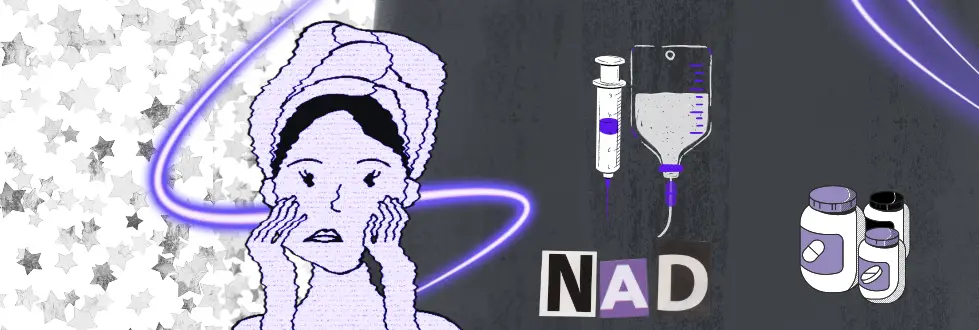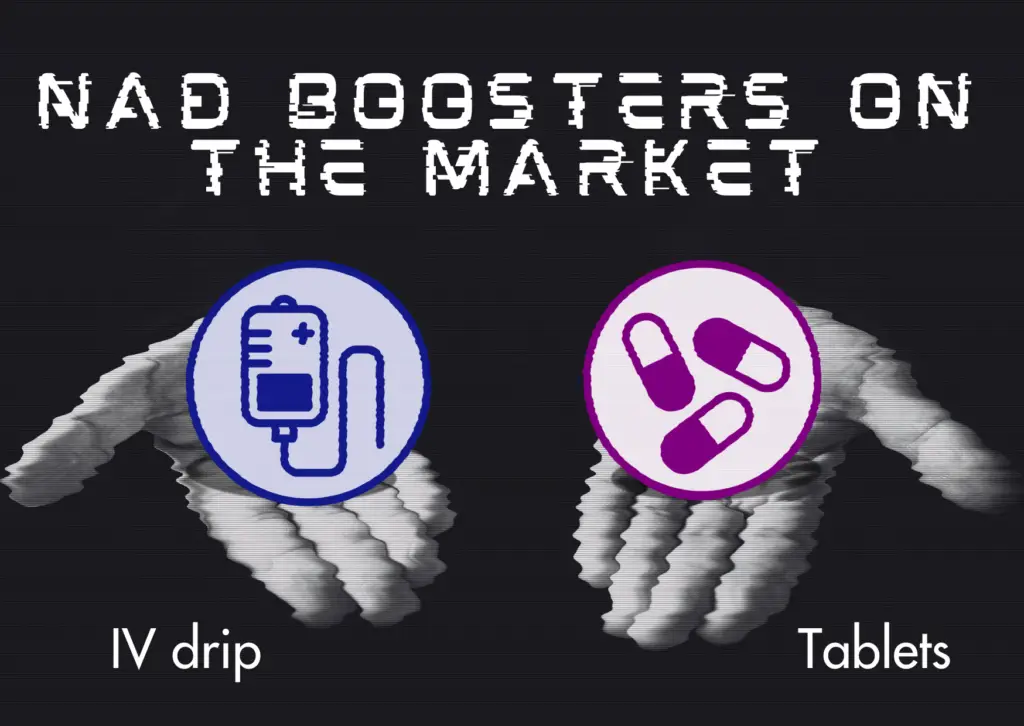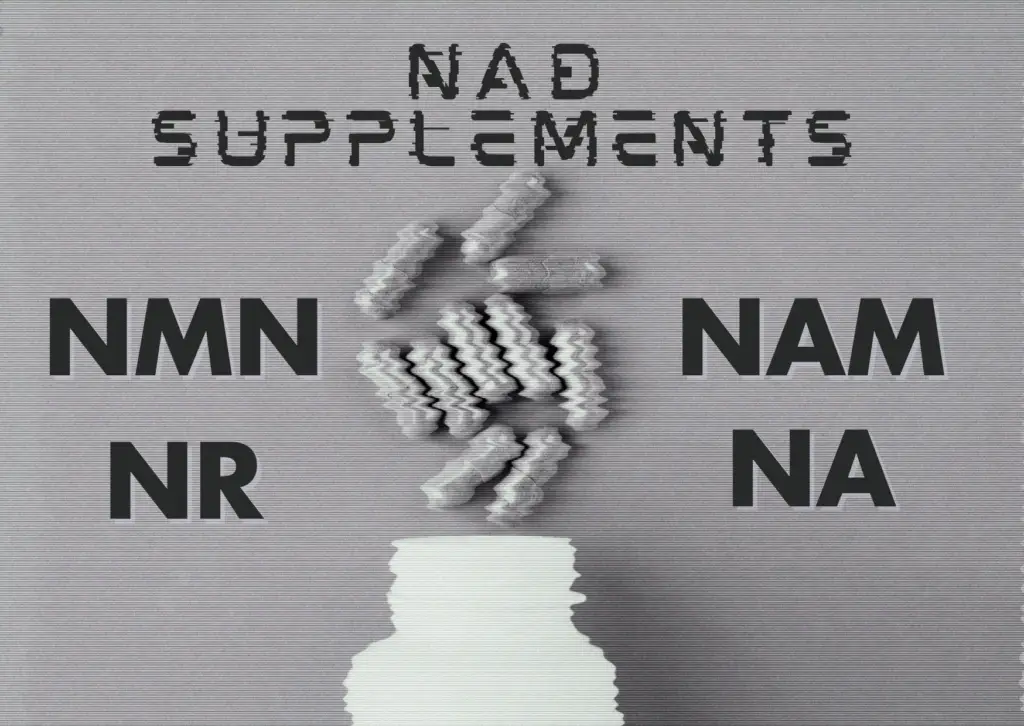
NAD boosting: a fountain of youth or a hopeful lie?
Anastasiia Marmyleva is a Doctoral researcher specialising in Biomedicine and Mitochondrial Biology. As a science communication enthusiast, she has served as a host at The Science Basement’s very own podcast. This blog is Anastasiia’s little passion project, inspired by her two favourite things: science and podcasting.
This article is part of the trials, errors and breakthroughs theme.
edited by mimmu, and illustrated by sophie and anastasiia, reviewed by liliya euro. Should you have any comments, please let us know!
For centuries, humanity has pursued a never-ending quest to bring back youth, stop ageing, and even avoid death itself. Many cultures across the globe have crafted legends of miraculous ways to achieve immortality. This enigma has inspired not only artists and writers, but it has also greatly motivated scientists.
In fact, science has largely advanced our understanding of what causes and accelerates ageing. Every day, researchers work meticulously to find ways to reverse the process. Compared to the past, the human lifespan and life expectancy have increased dramatically and continue to grow1,2. Many factors contribute to such improvements, from the enhanced quality of life to advancements in medicine. But while scientists are on a quest for eternal youth, the clock keeps ticking, bringing with it a sense of anxiety. Businesses smell the growing distress like vultures stalking their prey, and they offer a solution – NAD boosting.
So, meet Nicotinamide Adenine Dinucleotide (NAD) – a molecule that promises a simple solution to the inevitable problem of ageing. Since breaking into the international arena, NAD has seen a significant surge in popularity, becoming a centrepiece of a blossoming market of NAD-based treatments. NAD is one of the most abundant molecules in our cells and a crucial player in many vital processes, be it generating energy for the body or serving as a cofactor for numerous enzymes, whose activity extends lifespan (at least in animals)3,4,5. As we age, total NAD levels decrease, depleting many processes of this vital player6,7. Hence, the logical solution would be to replenish the dwindling NAD pools.
NAD-boosting comes in many flavours. For instance, for the hefty price of $1000, you can undergo an intravenous (IV) NAD ‘drip’ therapy. This powerful procedure guarantees not only to slow down ageing but also to rejuvenate the entire body. Its broad potential promises improvements in neurological functions, sleep, and the restoration of muscle strength, among many other benefits. A number of celebrities have been open about their use of NAD drip8. Search online, and you will find lists of influential people and types of NAD cocktails they have delivered straight into their bloodstreams.
In the case of Justin Bieber, NAD IV therapy helped in his challenging battle – not with ageing but with drug addiction.
‘I am here in the doctor’s office.’
Justin addresses the camera as he is getting ready for the procedure.
‘What we’re about to do is the nurse is going to put an IV, and it’s called NAD. Basically, what it does is it’s gonna flush out some of the toxins.’
If you are on a budget, there are plenty of substitutes for the IV, like NAD nasal sprays and self-injection kits, which can be delivered right to your doorstep. Alternatively, you can purchase so-called NAD boosters, the natural precursors of NAD: nicotinic acid (NA), nicotinamide riboside (NR), nicotinamide (NAM), and nicotinamide mononucleotide (NMN)9,10. These precursors are available for order in pill or powder form, ready for consumption, without any medical prescriptions. It sounds like the perfect solution!
…or does it?
Please hold on before you click the order button, as there is some fine print you should familiarize yourself with. It details the side effects that can accompany NAD-boosting treatments11. An IV drip, for instance, is a lengthy procedure, typically lasting several hours, with people reporting adverse effects such as nausea and cramps, among others. NAD boosters, on the other hand, come with their own set of problems: commercially available NA comes in 500 mg per pill while already at 50 mg, it can induce hot flushes12. Strong overdoses of NAM, on the other hand, have been reported to cause liver damage13,14.

As of October 2022, the marketing of NMN as a dietary supplement has been banned by the US Food and Drug Administration – a decision lobbied for by Metro International Biotech16. Intriguingly, its co-founder, Professor David Sinclair, has been an avid proponent of NAD boosting. During his interview on the Joe Rogan podcast back in 2021, Prof. Sinclair endorsed the consumption of anti-ageing supplements.
Mr. Rogan asks,
‘Now, when you’re a young person, like, if someone is 30 years old, they don’t need to do this, do they? Should they think about metformin and things along those lines at a very young age? ‘
To which Prof. Sinclair replies:
‘In my opinion, no. Because you’ve got your high levels of NAD, you’ve got your longevity genes activated. [ … ] the supplements, I think, save till your 30s because your body has the longevity and resilience in those years. But I’m speculating based on animal studies. We don’t know. Nobody’s done this kind of experiment, and this is the problem. They’re gonna know in 20–30 years [whether] what I’m saying is true or not. But we can’t wait that long. So, I do my best to extrapolate from animals and look at societies that live a long time and make the best I can scientific judgement as to what will work.’
So, what prompted such an outspoken NAD-boosting supporter and his company to call for the ban? Sadly, the precise reasons remain shrouded in mystery. On top of that, studies of NMN supplementation have been limited and often plagued by positive biases that emphasize the beneficial effects of this precursor. Fortunately, there is some emerging research investigating the potential drawbacks of NAD boosting.
A recent study in mice highlighted for the first time the detrimental effects of NMN supplementation on ageing kidneys: the low-grade inflammation typical of old kidneys was further aggravated by NMN supplementation16. Kidney injury markers and circulating uremic toxins were also higher in aged NMN-treated animals. These findings diverge from previous research, which showed many positive effects of NMN in muscles and the liver, highlighting that this molecule may work differently in different organs.
This study, along with Prof. Sinclair’s interview, brings up major challenges in current NAD research. The length of observations is crucial when considering longevity but becomes particularly strenuous in long-living humans. We can easily trace the effects of different interventions on the lifespans of animals, such as mice that live up to two years. However, because animal physiology differs from ours, findings in non-human subjects require careful interpretation and must be backed by clinical trials in people before medications can be introduced to the broader market or general clinical practice.
A range of clinical trials is available for certain NAD precursors, albeit with key limitations. For nicotinamide riboside, the longest observation period in healthy individuals was only 12 weeks. This short timeframe does not give us a proper understanding of the benefits and risks of the compound over years of consistent supplementation*17. To argue that NAD increases lifespan, test subjects need to be monitored for several years (ideally, the entirety of their lives).

Moreover, the currently conducted clinical studies are limited by small test group sizes18. Scaling up the groups would be necessary for more representative data and robust conclusions. This is obviously a costly and time-consuming endeavour, which will require long-term records of test subjects, high processing power, and potentially the commitment of several generations of scientists.
Much of the research so far has largely focused on specific outcomes of NAD boosting while overlooking its systemic effects on the body. Although NAD can be useful to slow down certain ageing processes, maintaining high levels might be risky in other conditions. We know by now that certain diseases require NAD for their development. For one, the arch nemesis of old age – cancer – depends on NAD to sustain its rapid growth. In certain types of tumours, high levels of NAD-producing enzymes are associated with poor prognosis in patients19,20,21. The question then stands: what should we do when we have an elderly patient with naturally decreasing NAD levels and a high risk of developing cancer?
One thing is certain: just as it is recommended to measure your vitamin and mineral levels before supplementing, it is of key importance to measure your NAD levels prior to boosting them. There are ways to do this with new and emerging technologies, and I strongly encourage you to consult your doctor before taking any action. The list of things to consider goes beyond just NAD levels: age, underlying medical conditions, and the form, means, length, and dosage of supplementation need to be considered. In the meantime, the research will keep moving towards a more comprehensive grasp of NAD’s multifaceted roles in our bodies.
* Longer clinical trials have investigated NR in the context of diseases for up to two years. They did not control for the effects of NR in people without the disease for which the drug was studied.
References
- Willingham E. Humans could live up to 150 years, new research suggests. SA Health & Medicine. (2021) Vol. 3 No. 4.
- Blagosklonny MV. No limit to maximal lifespan in humans: How to beat a 122-year-old record. Oncoscience. (2021) 8:110-119.
- Covarrubias AJ, Perrone R, Grozio A, Verdin E. NAD+ metabolism and its roles in cellular processes during ageing. Nat Rev Mol Cell Biol. (2021) 22(2):119-141.
- Xie N, Zhang L, Gao W, Huang C, Huber PE, Zhou X, Li C, Shen G, Zou B. NAD+ metabolism: Pathophysiologic mechanisms and therapeutic potential. Signal Transduct Target Ther. (2020) 5(1):227.
- Amjad S, Nisar S, Bhat AA, Shah AR, Frenneaux MP, Fakhro K, et al. Role of NAD+ in regulating cellular and metabolic signaling pathways. Mol Metab. (2021) 49:101195. doi: 10.1016/j.molmet.2021.101195.
- Camacho-Pereira J, Tarragó MG, Chini CCS, Nin V, Escande C, Warner GM, et al. CD38 dictates age-related NAD decline and mitochondrial dysfunction through an SIRT3-dependent mechanism. Cell Metab. (2016) 23(6):1127-1139.
- Yang F, Deng X, Yu Y, Luo L, Chen X, Zheng J, et al. Association of human whole blood NAD+ contents with aging. Front Endocrinol (Lausanne). (2022) 13:829658.
- Dougherty E. Meet NAD+, the latest celebrity biohacking trend. Elle. (2024) February.
- Yoshino J, Baur JA, Imai SI. NAD+ intermediates: The biology and therapeutic potential of NMN and NR. Cell Metab. (2018) 27(3):513-528. doi: 10.1016/j.cmet.2017.11.002.
- Canto C. NAD+ precursors: A questionable redundancy. Metabolites. (2022) 12(7):630. doi: 10.3390/metabo12070630.
- Braidy N, Liu Y. NAD+ therapy in age-related degenerative disorders: A benefit/risk analysis. Exp Gerontol. (2020) 132:110831.
- Minto C, Vecchio MG, Lamprecht M, Gregori D. Definition of a tolerable upper intake level of niacin: A systematic review and meta-analysis of the dose-dependent effects of nicotinamide and nicotinic acid supplementation. Nutr Rev. (2017) 75(6):471-490.
- Mahmoud YI, Mahmoud AA. Role of nicotinamide (vitamin B3) in acetaminophen-induced changes in rat liver: Nicotinamide effect in acetaminophen-damaged liver. Exp Toxicol Pathol. (2016) 68(6):345-354.
- Knip M, Douek IF, Moore WP, Gillmor HA, McLean AE, Bingley PJ, et al. Safety of high-dose nicotinamide: A review. Diabetologia. (2000) 43(11):1337-1345.
- U.S. Food and Drug Administration. NDI 1259 – B-Nicotinamide Mononucleotide (NMN) from Inner Mongolia Kingdomway Pharmaceutical Limited. (2022).
- Saleh TA, Whitson JA, Keiser P, Prasad P, Jenkins BC, Sodeinde T, et al. Metabolite accumulation from oral NMN supplementation drives aging-specific kidney inflammation. bioRxiv [Preprint]. (2024) May 6:2024.04.09.588624.
- Martens CR, Denman BA, Mazzo MR, Armstrong ML, Reisdorph N, McQueen MB, et al. Chronic nicotinamide riboside supplementation is well-tolerated and elevates NAD+ in healthy middle-aged and older adults. Nat Commun. (2018) 9(1):1286.
- Poljšak B, Kovač V, Milisav I. Current uncertainties and future challenges regarding NAD+ boosting strategies. Antioxidants (Basel). (2022) 11(9):1637.
- Cui C, Qi J, Deng Q, Chen R, Zhai D, Yu J. Nicotinamide mononucleotide adenylyl transferase 2: A promising diagnostic and therapeutic target for colorectal cancer. Biomed Res Int. (2016) 2016:1804137.
- Li W, Gao M, Hu C, Chen X, Zhou Y. NMNAT2: An important metabolic enzyme affecting disease progression. Biomed Pharmacother. (2023) 158:114143.
- Perryman R, Chau TW, De-Felice J, O’Neill K, Syed N. Distinct capabilities in NAD metabolism mediate resistance to NAMPT inhibition in glioblastoma. Cancers (Basel). (2024) 16(11):2054.